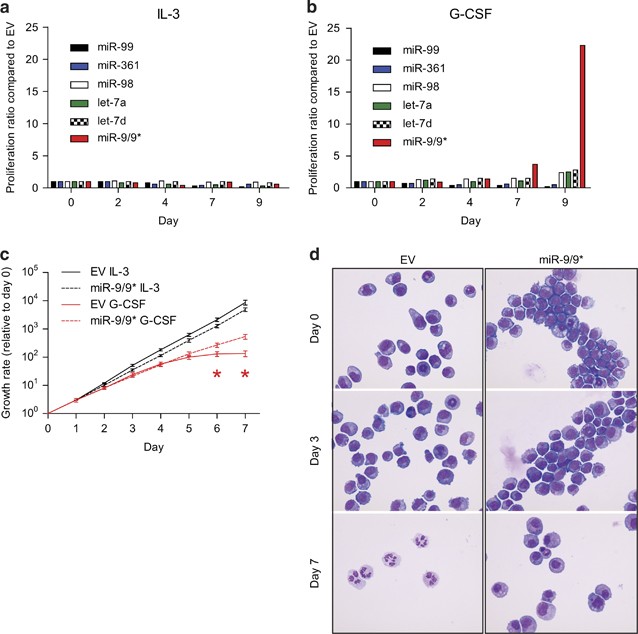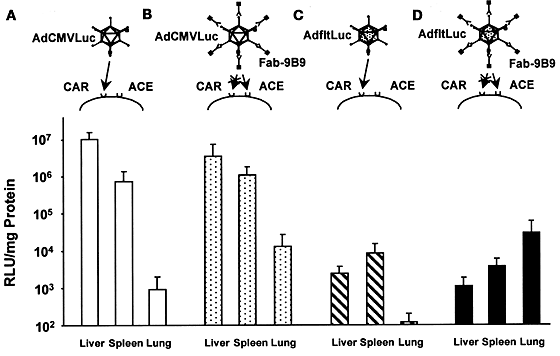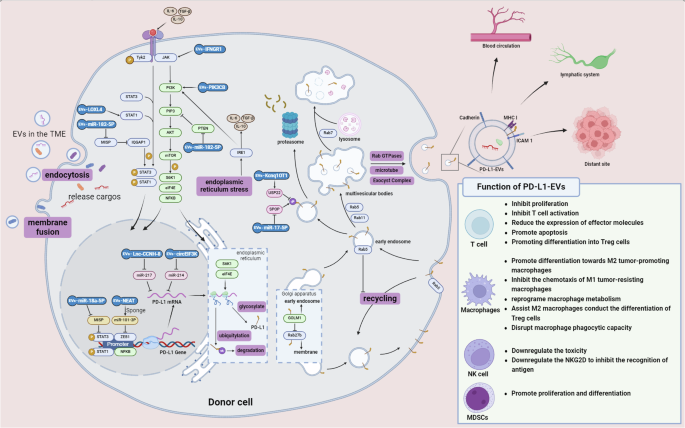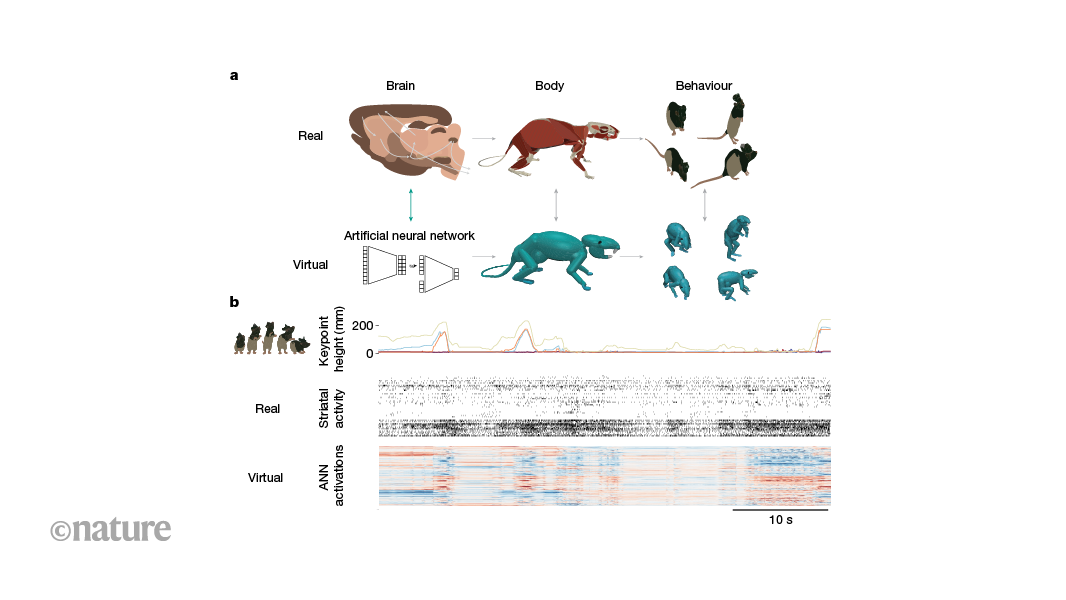
- Select a language for the TTS:
- UK English Female
- UK English Male
- US English Female
- US English Male
- Australian Female
- Australian Male
- Language selected: (auto detect) - EN
Play all audios:
ABSTRACT Aberrant post-transcriptional regulation by microRNAs (miRNAs) has been shown to be involved in the pathogenesis of acute myeloid leukemia (AML). In a previous study, we performed a
large functional screen using a retroviral barcoded miRNA expression library. Here, we report that overexpression of miR-9/9* in myeloid 32D cell line (32D-miR-9/9*) had profound impact on
granulocyte colony-stimulating factor-induced differentiation. Further _in vitro_ studies showed that enforced expression of miR-9/9* blocked normal neutrophil development in 32D and in
primary murine lineage-negative bone marrow cells. We examined the expression of miR-9/9* in a cohort of 647 primary human AMLs. In most cases, miR-9 and miR-9* were significantly
upregulated and their expression levels varied according to AML subtype, with the highest expression in _MLL_-related leukemias harboring 11q23 abnormalities and the lowest expression in AML
cases with t(8;21) and biallelic mutations in _CEBPA_. Gene expression profiling of AMLs with high expression of miR-9/9* and 32D-miR-9/9* identified ETS-related gene (_Erg_) as the only
common potential target. Upregulation of ERG in 32D cells rescued miR-9/9*-induced block in neutrophil differentiation. Taken together, this study demonstrates that miR-9/9* are aberrantly
expressed in most of AML cases and interfere with normal neutrophil differentiation by downregulation of ERG. Access through your institution Buy or subscribe This is a preview of
subscription content, access via your institution ACCESS OPTIONS Access through your institution Subscribe to this journal Receive 12 print issues and online access $259.00 per year only
$21.58 per issue Learn more Buy this article * Purchase on SpringerLink * Instant access to full article PDF Buy now Prices may be subject to local taxes which are calculated during checkout
ADDITIONAL ACCESS OPTIONS: * Log in * Learn about institutional subscriptions * Read our FAQs * Contact customer support SIMILAR CONTENT BEING VIEWED BY OTHERS OVEREXPRESSION OF MIR-99A
PROMOTED EXPANSION AND SUPPRESSED DIFFERENTIATION OF HEMATOPOIETIC STEM/PROGENITOR CELLS Article Open access 14 March 2025 THE PROTO-ONCOGENIC MIR-106A-363 CLUSTER ENHANCES ADVERSE RISK
ACUTE MYELOID LEUKEMIA THROUGH MITOCHONDRIAL ACTIVATION Article 17 March 2025 EXPLORING THE POTENTIAL OF PREDICTED MIRNAS ON THE GENES INVOLVED IN THE EXPANSION OF HEMATOPOIETIC STEM CELLS
Article Open access 05 July 2024 REFERENCES * Döhner H, Estey EH, Amadori S, Appelbaum FR, Buchner T, Burnett AK _et al_. Diagnosis and management of acute myeloid leukemia in adults:
recommendations from an international expert panel, on behalf of the European LeukemiaNet. _Blood_ 2010; 115: 453–474. Article Google Scholar * Reikvam H, Hatfield KJ, Kittang AO, Hovland
R, Bruserud O . Acute myeloid leukemia with the t(8;21) translocation: clinical consequences and biological implications. _J Biomed Biotechnol_ 2011; 2011: 104631. Article Google Scholar *
Verhaak RG, Goudswaard CS, van Putten W, Bijl MA, Sanders MA, Hugens W _et al_. Mutations in nucleophosmin (NPM1) in acute myeloid leukemia (AML): association with other gene abnormalities
and previously established gene expression signatures and their favorable prognostic significance. _Blood_ 2005; 106: 3747–3754. Article CAS Google Scholar * Döhner K, Döhner H .
Molecular characterization of acute myeloid leukemia. _Haematologica_ 2008; 93: 976–982. Article Google Scholar * Fröhling S, Scholl C, Gilliland DG, Levine RL . Genetics of myeloid
malignancies: pathogenetic and clinical implications. _J Clin Oncol_ 2005; 23: 6285–6295. Article Google Scholar * Figueroa ME, Lugthart S, Li Y, Erpelinck-Verschueren C, Deng X, Christos
PJ _et al_. DNA methylation signatures identify biologically distinct subtypes in acute myeloid leukemia. _Cancer Cell_ 2010; 17: 13–27. Article CAS Google Scholar * Jongen-Lavrencic M,
Sun SM, Dijkstra MK, Valk PJ, Löwenberg B . MicroRNA expression profiling in relation to the genetic heterogeneity of acute myeloid leukemia. _Blood_ 2008; 111: 5078–5085. Article CAS
Google Scholar * Ley TJ, Ding L, Walter MJ, McLellan MD, Lamprecht T, Larson DE _et al_. DNMT3A mutations in acute myeloid leukemia. _N Engl J Med_ 2010; 363: 2424–2433. Article CAS
Google Scholar * Wang GG, Cai L, Pasillas MP, Kamps MP . NUP98-NSD1 links H3K36 methylation to Hox-A gene activation and leukaemogenesis. _Nat Cell Biol_ 2007; 9: 804–812. Article CAS
Google Scholar * Bartel DP . MicroRNAs: genomics, biogenesis, mechanism, and function. _Cell_ 2004; 116: 281–297. Article CAS Google Scholar * Ding XC, Weiler J, Grosshans H . Regulating
the regulators: mechanisms controlling the maturation of microRNAs. _Trends Biotechnol_ 2009; 27: 27–36. Article CAS Google Scholar * Eulalio A, Huntzinger E, Nishihara T, Rehwinkel J,
Fauser M, Izaurralde E . Deadenylation is a widespread effect of miRNA regulation. _RNA_ 2009; 15: 21–32. Article CAS Google Scholar * Schraivogel D, Weinmann L, Beier D, Tabatabai G,
Eichner A, Zhu JY _et al_. CAMTA1 is a novel tumour suppressor regulated by miR-9/9* in glioblastoma stem cells. _EMBO J_ 2011; 30: 4309–4322. Article CAS Google Scholar * Hsu PY,
Deatherage DE, Rodriguez BA, Liyanarachchi S, Weng YI, Zuo T _et al_. Xenoestrogen-induced epigenetic repression of microRNA-9-3 in breast epithelial cells. _Cancer Res_ 2009; 69: 5936–5945.
Article CAS Google Scholar * Eyholzer M, Schmid S, Schardt JA, Haefliger S, Mueller BU, Pabst T . Complexity of miR-223 regulation by CEBPA in human AML. _Leuk Res_ 2010; 34: 672–676.
Article CAS Google Scholar * Pulikkan JA, Dengler V, Peramangalam PS, Peer Zada AA, Muller-Tidow C, Bohlander SK _et al_. Cell-cycle regulator E2F1 and microRNA-223 comprise an
autoregulatory negative feedback loop in acute myeloid leukemia. _Blood_ 2010; 115: 1768–1778. Article CAS Google Scholar * Popovic R, Riesbeck LE, Velu CS, Chaubey A, Zhang J, Achille NJ
_et al_. Regulation of mir-196b by MLL and its overexpression by MLL fusions contributes to immortalization. _Blood_ 2009; 113: 3314–3322. Article CAS Google Scholar * Garzon R, Heaphy
CE, Havelange V, Fabbri M, Volinia S, Tsao T _et al_. MicroRNA 29b functions in acute myeloid leukemia. _Blood_ 2009; 114: 5331–5341. Article CAS Google Scholar * Bousquet M, Quelen C,
Rosati R, Mansat-De Mas V, La Starza R, Bastard C _et al_. Myeloid cell differentiation arrest by miR-125b-1 in myelodysplastic syndrome and acute myeloid leukemia with the t(2;11)(p21;q23)
translocation. _J Exp Med_ 2008; 205: 2499–2506. Article CAS Google Scholar * Garzon R, Garofalo M, Martelli MP, Briesewitz R, Wang L, Fernandez-Cymering C _et al_. Distinctive microRNA
signature of acute myeloid leukemia bearing cytoplasmic mutated nucleophosmin. _Proc Natl Acad Sci USA_ 2008; 105: 3945–3950. Article CAS Google Scholar * Marcucci G, Radmacher MD,
Maharry K, Mrozek K, Ruppert AS, Paschka P _et al_. MicroRNA expression in cytogenetically normal acute myeloid leukemia. _N Engl J Med_ 2008; 358: 1919–1928. Article CAS Google Scholar *
Chen P, Price C, Li Z, Li Y, Cao D, Wiley A _et al_. miR-9 is an essential oncogenic microRNA specifically overexpressed in mixed lineage leukemia-rearranged leukemia. _Proc Natl Acad Sci
USA_ 2013; 110: 11511–11516. Article CAS Google Scholar * Emmrich S, Katsman-Kuipers JE, Henke K, Khatib ME, Jammal R, Engeland F _et al_. miR-9 is a tumor suppressor in pediatric AML
with t(8;21). _Leukemia_ 2014; 28: 1022–1032. Article CAS Google Scholar * Packer AN, Xing Y, Harper SQ, Jones L, Davidson BL . The bifunctional microRNA miR-9/miR-9* regulates REST and
CoREST and is downregulated in Huntington's disease. _J Neurosci_ 2008; 28: 14341–14346. Article CAS Google Scholar * Leucht C, Stigloher C, Wizenmann A, Klafke R, Folchert A,
Bally-Cuif L . MicroRNA-9 directs late organizer activity of the midbrain-hindbrain boundary. _Nat Neurosci_ 2008; 11: 641–648. Article CAS Google Scholar * Ma L, Young J, Prabhala H, Pan
E, Mestdagh P, Muth D _et al_. miR-9, a MYC/MYCN-activated microRNA, regulates E-cadherin and cancer metastasis. _Nat Cell Biol_ 2010; 12: 247–256. Article CAS Google Scholar * Zhao C,
Sun G, Li S, Shi Y . A feedback regulatory loop involving microRNA-9 and nuclear receptor TLX in neural stem cell fate determination. _Nat Struct Mol Biol_ 2009; 16: 365–371. Article CAS
Google Scholar * Zhu L, Chen H, Zhou D, Li D, Bai R, Zheng S _et al_. MicroRNA-9 up-regulation is involved in colorectal cancer metastasis via promoting cell motility. _Med Oncol_ 2012; 29:
1037–1043. Article CAS Google Scholar * Bazzoni F, Rossato M, Fabbri M, Gaudiosi D, Mirolo M, Mori L _et al_. Induction and regulatory function of miR-9 in human monocytes and
neutrophils exposed to proinflammatory signals. _Proc Natl Acad Sci USA_ 2009; 106: 5282–5287. Article CAS Google Scholar * Lukiw WJ, Pogue AI . Induction of specific micro RNA (miRNA)
species by ROS-generating metal sulfates in primary human brain cells. _J Inorg Biochem_ 2007; 101: 1265–1269. Article CAS Google Scholar * Yu T, Liu K, Wu Y, Fan J, Chen J, Li C _et al_.
MicroRNA-9 inhibits the proliferation of oral squamous cell carcinoma cells by suppressing expression of CXCR4 via the Wnt/beta-catenin signaling pathway. _Oncogene_ 2014; 33: 5017–5027.
Article CAS Google Scholar * Wang J, Yang B, Han L, Li X, Tao H, Zhang S _et al_. Demethylation of miR-9-3 and miR-193a genes suppresses proliferation and promotes apoptosis in non-small
cell lung cancer cell lines. _Cell Physiol Biochem_ 2013; 32: 1707–1719. Article CAS Google Scholar * Sun SM, Rockova V, Bullinger L, Dijkstra MK, Döhner H, Löwenberg B _et al_. The
prognostic relevance of miR-212 expression with survival in cytogenetically and molecularly heterogeneous AML. _Leukemia_ 2013; 27: 100–106. Article CAS Google Scholar * Meenhuis A, van
Veelen PA, de Looper H, van Boxtel N, van den Berge IJ, Sun SM _et al_. MiR-17/20/93/106 promote hematopoietic cell expansion by targeting sequestosome 1-regulated pathways in mice. _Blood_
2011; 118: 916–925. Article CAS Google Scholar * de Koning JP, Soede-Bobok AA, Ward AC, Schelen AM, Antonissen C, van Leeuwen D _et al_. STAT3-mediated differentiation and survival and of
myeloid cells in response to granulocyte colony-stimulating factor: role for the cyclin-dependent kinase inhibitor p27(Kip1). _Oncogene_ 2000; 19: 3290–3298. Article CAS Google Scholar *
Kalina T, Flores-Montero J, van der Velden VH, Martin-Ayuso M, Böttcher S, Ritgen M _et al_. EuroFlow Consortium (EU-FP6, LSHB-CT-2006-018708). EuroFlow standardization of flow cytometer
instrument settings and immunophenotyping protocols. _Leukemia_ 2012; 26: 1986–2010. Article CAS Google Scholar * van Dongen JJ, Lhermitte L, Böttcher S, Almeida J, van der Velden VH,
Flores-Montero J _et al_. EuroFlow Consortium (EU-FP6, LSHB-CT-2006-018708). EuroFlow antibody panels for standardized n-dimensional flow cytometric immunophenotyping of normal, reactive and
malignant leukocytes. _Leukemia_ 2012; 26: 1908–1975. Article CAS Google Scholar * Valk PJ, Verhaak RG, Beijen MA, Erpelinck CA, Barjesteh van Waalwijk van Doorn-Khosrovani S, Boer JM
_et al_. Prognostically useful gene-expression profiles in acute myeloid leukemia. _N Engl J Med_ 2004; 350: 1617–1628. Article CAS Google Scholar * Sun SM, Dijkstra MK, Bijkerk AC,
Brooimans RA, Valk PJ, Erkeland SJ _et al_. Transition of highly specific microRNA expression patterns in association with discrete maturation stages of human granulopoiesis. _Br J Haematol_
2011; 155: 395–398. Article CAS Google Scholar * Arora H, Qureshi R, Jin S, Park AK, Park WY . miR-9 and let-7g enhance the sensitivity to ionizing radiation by suppression of NFkappaB1.
_Exp Mol Med_ 2011; 43: 298–304. Article CAS Google Scholar * Liu S, Kumar SM, Lu H, Liu A, Yang R, Pushparajan A _et al_. MicroRNA-9 up-regulates E-cadherin through inhibition of
NF-kappaB1-Snail1 pathway in melanoma. _J Pathol_ 2012; 226: 61–72. Article CAS Google Scholar * Carrère S, Verger A, Flourens A, Stehelin D, Duterque-Coquillaud M . Erg proteins,
transcription factors of the Ets family, form homo, heterodimers and ternary complexes via two distinct domains. _Oncogene_ 1998; 16: 3261–3268. Article Google Scholar * Taoudi S, Bee T,
Hilton A, Knezevic K, Scott J, Willson TA _et al_. ERG dependence distinguishes developmental control of hematopoietic stem cell maintenance from hematopoietic specification. _Genes Dev_
2011; 25: 251–262. Article CAS Google Scholar * Loughran SJ, Kruse EA, Hacking DF, de Graaf CA, Hyland CD, Willson TA _et al_. The transcription factor Erg is essential for definitive
hematopoiesis and the function of adult hematopoietic stem cells. _Nat Immunol_ 2008; 9: 810–819. Article CAS Google Scholar * Ng AP, Loughran SJ, Metcalf D, Hyland CD, de Graaf CA, Hu Y
_et al_. Erg is required for self-renewal of hematopoietic stem cells during stress hematopoiesis in mice. _Blood_ 2011; 118: 2454–2461. Article CAS Google Scholar * Wilson NK, Foster SD,
Wang X, Knezevic K, Schutte J, Kaimakis P _et al_. Combinatorial transcriptional control in blood stem/progenitor cells: genome-wide analysis of ten major transcriptional regulators. _Cell
Stem Cell_ 2010; 7: 532–544. Article CAS Google Scholar * Thoms JA, Birger Y, Foster S, Knezevic K, Kirschenbaum Y, Chandrakanthan V _et al_. ERG promotes T-acute lymphoblastic leukemia
and is transcriptionally regulated in leukemic cells by a stem cell enhancer. _Blood_ 2011; 117: 7079–7089. Article CAS Google Scholar * Carmichael CL, Metcalf D, Henley KJ, Kruse EA, Di
Rago L, Mifsud S _et al_. Hematopoietic overexpression of the transcription factor Erg induces lymphoid and erythro-megakaryocytic leukemia. _Proc Natl Acad Sci USA_ 2012; 109: 15437–15442.
Article CAS Google Scholar * Tursky ML, Beck D, Thoms JA, Huang Y, Kumari A, Unnikrishnan A _et al_. Overexpression of ERG in cord blood progenitors promotes expansion and recapitulates
molecular signatures of high ERG leukemias. _Leukemia_ 2014; 29: 819–827. Article Google Scholar Download references ACKNOWLEDGEMENTS This study was supported in part by an Erasmus MC
grant (to MJL), Dutch Cancer Society grant (EMCR2009-4472 to MJL) and the Deutsche Forschungsgemeinschaft (SFB 1074 project B03 to LB). LB was supported in part by the Deutsche
Forschungsgemeinschaft (Heisenberg-Stipendium BU 1339/3-1). We thank Dr VHJ van der Velden for help with flow cytometric analysis, Dr PJM Valk for providing the Dutch AML data set and
critical revision of the manuscript and Professor Dr HR Delwel for his mentorship and contribution to interpretation of the data. AUTHOR CONTRIBUTIONS KN and SMS planned, carried out the
experiments and analyzed the data. LB and HD provided the German data set and carried out experiments. KvL performed morphological evaluation and quantification of cytospins. SJE, CE and MKD
performed experiments. EMJB, SJE, HD, LB, BL and MJL designed the study and interpreted the results. KN, SMS, SJE, LB, HD, BL and MJL wrote or contributed to the manuscript. AUTHOR
INFORMATION Author notes * K Nowek and S M Sun: These authors contributed equally to this work. AUTHORS AND AFFILIATIONS * Department of Hematology, Erasmus University Medical Center Cancer
Institute, Rotterdam, The Netherlands K Nowek, S M Sun, E M J Bindels, C Exalto, M K Dijkstra, K van Lom, S J Erkeland, B Löwenberg & M Jongen-Lavrencic * Department of Internal Medicine
III, University of Ulm, Ulm, Germany L Bullinger & H Döhner Authors * K Nowek View author publications You can also search for this author inPubMed Google Scholar * S M Sun View author
publications You can also search for this author inPubMed Google Scholar * L Bullinger View author publications You can also search for this author inPubMed Google Scholar * E M J Bindels
View author publications You can also search for this author inPubMed Google Scholar * C Exalto View author publications You can also search for this author inPubMed Google Scholar * M K
Dijkstra View author publications You can also search for this author inPubMed Google Scholar * K van Lom View author publications You can also search for this author inPubMed Google Scholar
* H Döhner View author publications You can also search for this author inPubMed Google Scholar * S J Erkeland View author publications You can also search for this author inPubMed Google
Scholar * B Löwenberg View author publications You can also search for this author inPubMed Google Scholar * M Jongen-Lavrencic View author publications You can also search for this author
inPubMed Google Scholar CORRESPONDING AUTHOR Correspondence to M Jongen-Lavrencic. ETHICS DECLARATIONS COMPETING INTERESTS The authors declare no conflict of interest. ADDITIONAL INFORMATION
Supplementary Information accompanies this paper on the Leukemia website SUPPLEMENTARY INFORMATION SUPPLEMENTARY INFORMATION 1 (PDF 4877 KB) SUPPLEMENTARY INFORMATION 2 (PDF 805 KB) RIGHTS
AND PERMISSIONS Reprints and permissions ABOUT THIS ARTICLE CITE THIS ARTICLE Nowek, K., Sun, S., Bullinger, L. _et al._ Aberrant expression of miR-9/9* in myeloid progenitors inhibits
neutrophil differentiation by post-transcriptional regulation of ERG. _Leukemia_ 30, 229–237 (2016). https://doi.org/10.1038/leu.2015.183 Download citation * Received: 20 January 2015 *
Revised: 18 June 2015 * Accepted: 22 June 2015 * Published: 15 July 2015 * Issue Date: January 2016 * DOI: https://doi.org/10.1038/leu.2015.183 SHARE THIS ARTICLE Anyone you share the
following link with will be able to read this content: Get shareable link Sorry, a shareable link is not currently available for this article. Copy to clipboard Provided by the Springer
Nature SharedIt content-sharing initiative




